Traditional Budgeting vs. Beyond Budgeting: A Critical Evaluation
VerifiedAdded on 2023/04/25
|13
|3288
|121
Report
AI Summary
This report critically examines traditional budgeting models, highlighting their limitations such as inflexibility, time consumption, and inaccurate goal depiction. It contrasts these with the beyond budgeting model, which offers benefits like fostering competitiveness, motivating individuals, enabling operational management, and promoting transparency. The analysis emphasizes the shift towards more adaptive and devolved budgeting approaches to meet the evolving demands of the business environment. Desklib provides access to this document along with other solved assignments and past papers for students.

BUDGETING MODELS
1
BUDGETING MODELS
Students name
Professors name
Date
1
BUDGETING MODELS
Students name
Professors name
Date
Paraphrase This Document
Need a fresh take? Get an instant paraphrase of this document with our AI Paraphraser
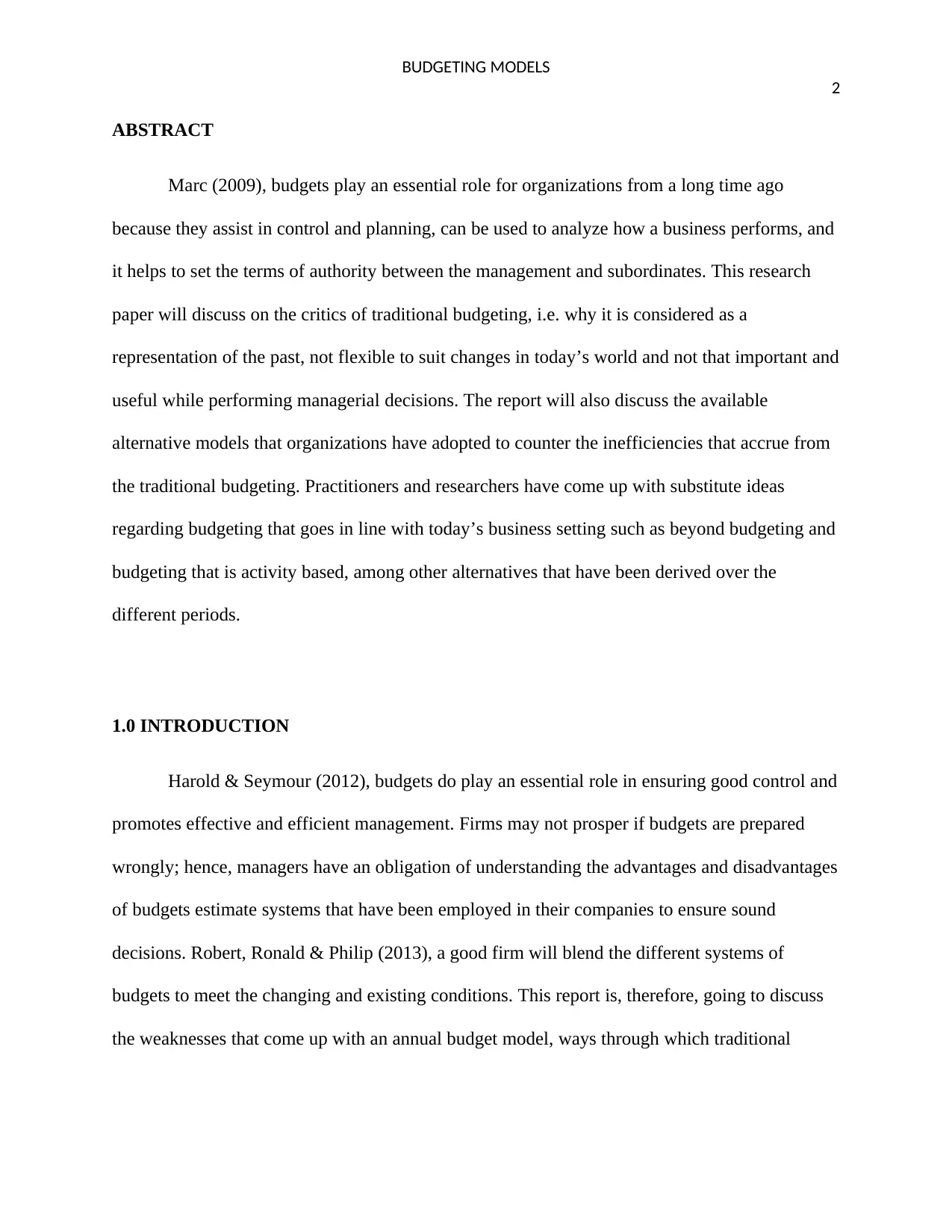
BUDGETING MODELS
2
ABSTRACT
Marc (2009), budgets play an essential role for organizations from a long time ago
because they assist in control and planning, can be used to analyze how a business performs, and
it helps to set the terms of authority between the management and subordinates. This research
paper will discuss on the critics of traditional budgeting, i.e. why it is considered as a
representation of the past, not flexible to suit changes in today’s world and not that important and
useful while performing managerial decisions. The report will also discuss the available
alternative models that organizations have adopted to counter the inefficiencies that accrue from
the traditional budgeting. Practitioners and researchers have come up with substitute ideas
regarding budgeting that goes in line with today’s business setting such as beyond budgeting and
budgeting that is activity based, among other alternatives that have been derived over the
different periods.
1.0 INTRODUCTION
Harold & Seymour (2012), budgets do play an essential role in ensuring good control and
promotes effective and efficient management. Firms may not prosper if budgets are prepared
wrongly; hence, managers have an obligation of understanding the advantages and disadvantages
of budgets estimate systems that have been employed in their companies to ensure sound
decisions. Robert, Ronald & Philip (2013), a good firm will blend the different systems of
budgets to meet the changing and existing conditions. This report is, therefore, going to discuss
the weaknesses that come up with an annual budget model, ways through which traditional
2
ABSTRACT
Marc (2009), budgets play an essential role for organizations from a long time ago
because they assist in control and planning, can be used to analyze how a business performs, and
it helps to set the terms of authority between the management and subordinates. This research
paper will discuss on the critics of traditional budgeting, i.e. why it is considered as a
representation of the past, not flexible to suit changes in today’s world and not that important and
useful while performing managerial decisions. The report will also discuss the available
alternative models that organizations have adopted to counter the inefficiencies that accrue from
the traditional budgeting. Practitioners and researchers have come up with substitute ideas
regarding budgeting that goes in line with today’s business setting such as beyond budgeting and
budgeting that is activity based, among other alternatives that have been derived over the
different periods.
1.0 INTRODUCTION
Harold & Seymour (2012), budgets do play an essential role in ensuring good control and
promotes effective and efficient management. Firms may not prosper if budgets are prepared
wrongly; hence, managers have an obligation of understanding the advantages and disadvantages
of budgets estimate systems that have been employed in their companies to ensure sound
decisions. Robert, Ronald & Philip (2013), a good firm will blend the different systems of
budgets to meet the changing and existing conditions. This report is, therefore, going to discuss
the weaknesses that come up with an annual budget model, ways through which traditional
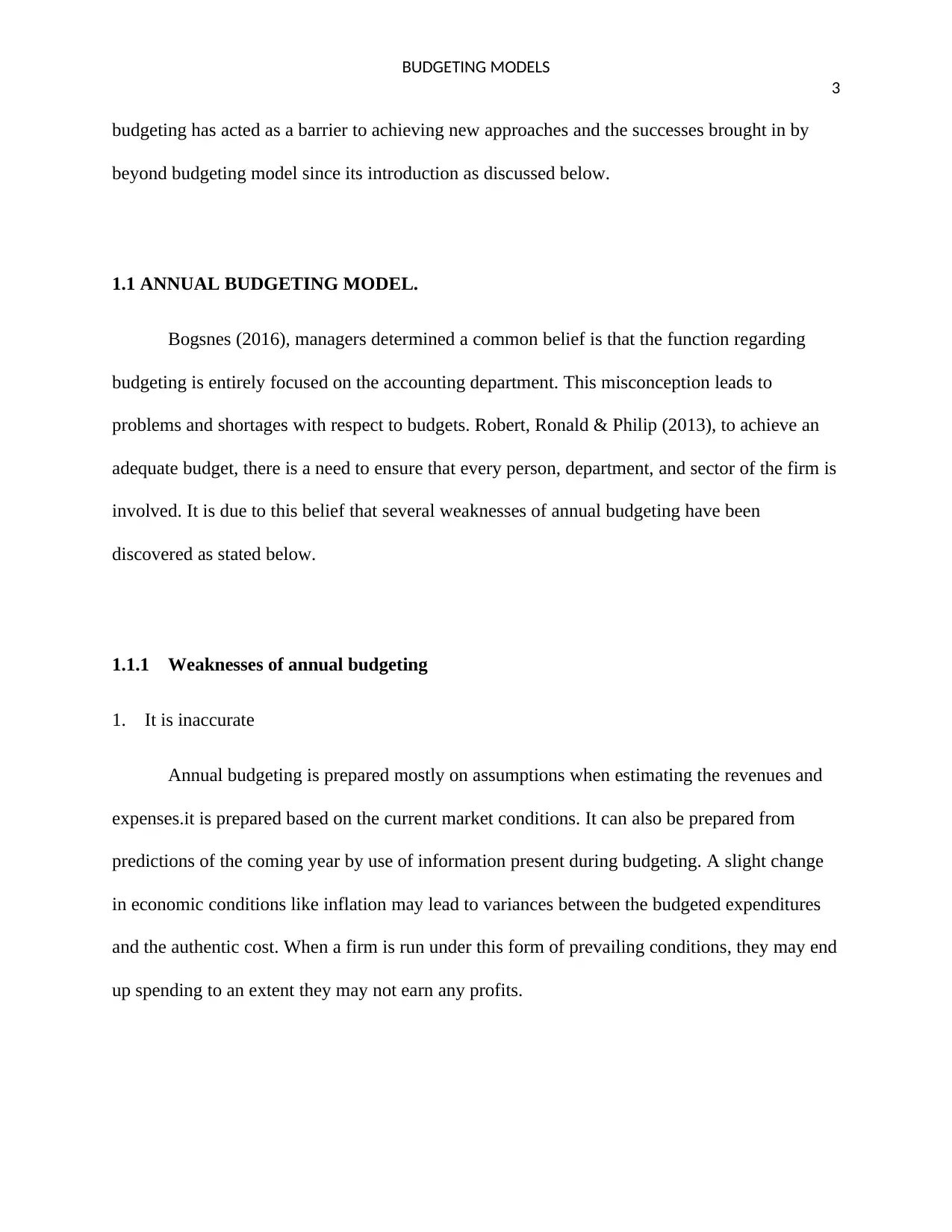
BUDGETING MODELS
3
budgeting has acted as a barrier to achieving new approaches and the successes brought in by
beyond budgeting model since its introduction as discussed below.
1.1 ANNUAL BUDGETING MODEL.
Bogsnes (2016), managers determined a common belief is that the function regarding
budgeting is entirely focused on the accounting department. This misconception leads to
problems and shortages with respect to budgets. Robert, Ronald & Philip (2013), to achieve an
adequate budget, there is a need to ensure that every person, department, and sector of the firm is
involved. It is due to this belief that several weaknesses of annual budgeting have been
discovered as stated below.
1.1.1 Weaknesses of annual budgeting
1. It is inaccurate
Annual budgeting is prepared mostly on assumptions when estimating the revenues and
expenses.it is prepared based on the current market conditions. It can also be prepared from
predictions of the coming year by use of information present during budgeting. A slight change
in economic conditions like inflation may lead to variances between the budgeted expenditures
and the authentic cost. When a firm is run under this form of prevailing conditions, they may end
up spending to an extent they may not earn any profits.
3
budgeting has acted as a barrier to achieving new approaches and the successes brought in by
beyond budgeting model since its introduction as discussed below.
1.1 ANNUAL BUDGETING MODEL.
Bogsnes (2016), managers determined a common belief is that the function regarding
budgeting is entirely focused on the accounting department. This misconception leads to
problems and shortages with respect to budgets. Robert, Ronald & Philip (2013), to achieve an
adequate budget, there is a need to ensure that every person, department, and sector of the firm is
involved. It is due to this belief that several weaknesses of annual budgeting have been
discovered as stated below.
1.1.1 Weaknesses of annual budgeting
1. It is inaccurate
Annual budgeting is prepared mostly on assumptions when estimating the revenues and
expenses.it is prepared based on the current market conditions. It can also be prepared from
predictions of the coming year by use of information present during budgeting. A slight change
in economic conditions like inflation may lead to variances between the budgeted expenditures
and the authentic cost. When a firm is run under this form of prevailing conditions, they may end
up spending to an extent they may not earn any profits.
⊘ This is a preview!⊘
Do you want full access?
Subscribe today to unlock all pages.

Trusted by 1+ million students worldwide
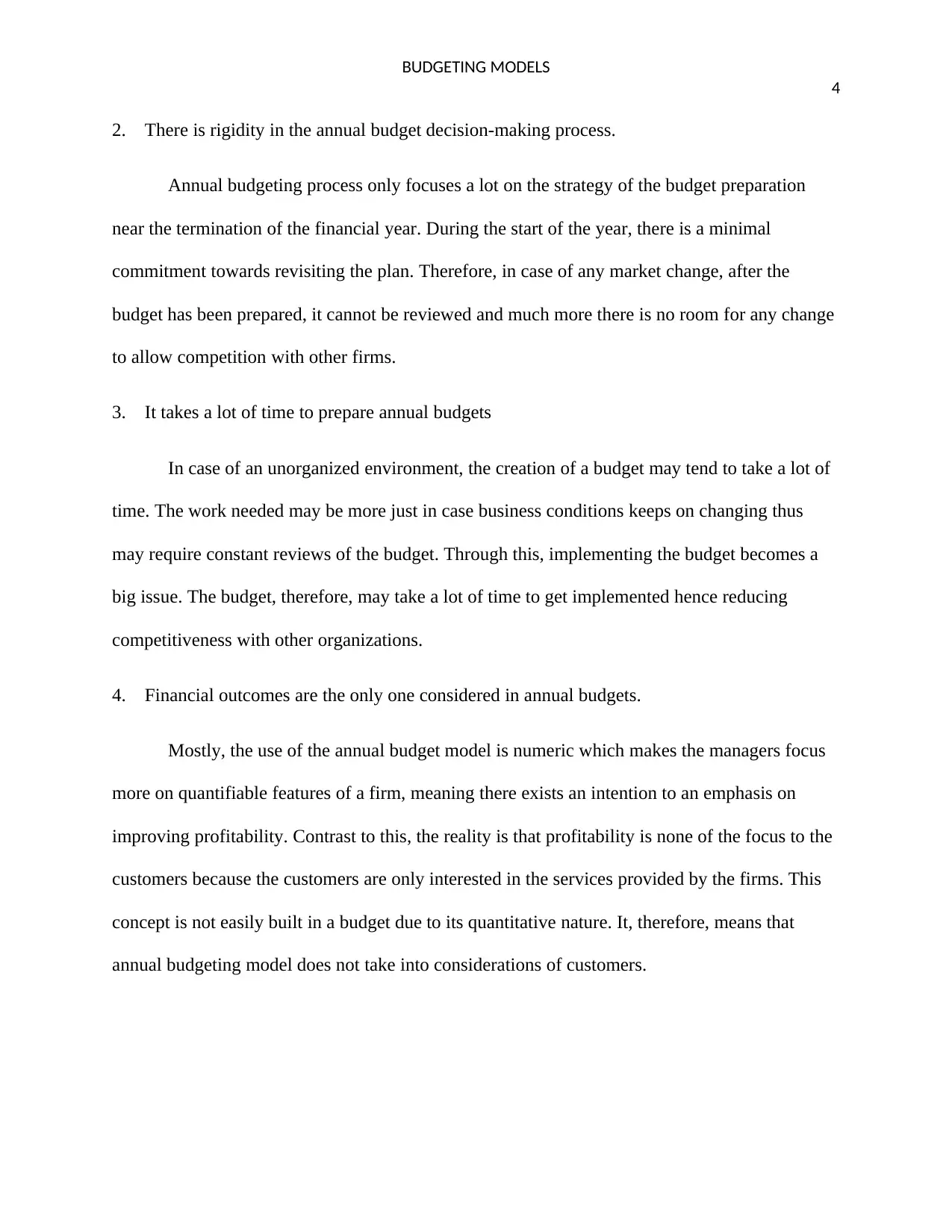
BUDGETING MODELS
4
2. There is rigidity in the annual budget decision-making process.
Annual budgeting process only focuses a lot on the strategy of the budget preparation
near the termination of the financial year. During the start of the year, there is a minimal
commitment towards revisiting the plan. Therefore, in case of any market change, after the
budget has been prepared, it cannot be reviewed and much more there is no room for any change
to allow competition with other firms.
3. It takes a lot of time to prepare annual budgets
In case of an unorganized environment, the creation of a budget may tend to take a lot of
time. The work needed may be more just in case business conditions keeps on changing thus
may require constant reviews of the budget. Through this, implementing the budget becomes a
big issue. The budget, therefore, may take a lot of time to get implemented hence reducing
competitiveness with other organizations.
4. Financial outcomes are the only one considered in annual budgets.
Mostly, the use of the annual budget model is numeric which makes the managers focus
more on quantifiable features of a firm, meaning there exists an intention to an emphasis on
improving profitability. Contrast to this, the reality is that profitability is none of the focus to the
customers because the customers are only interested in the services provided by the firms. This
concept is not easily built in a budget due to its quantitative nature. It, therefore, means that
annual budgeting model does not take into considerations of customers.
4
2. There is rigidity in the annual budget decision-making process.
Annual budgeting process only focuses a lot on the strategy of the budget preparation
near the termination of the financial year. During the start of the year, there is a minimal
commitment towards revisiting the plan. Therefore, in case of any market change, after the
budget has been prepared, it cannot be reviewed and much more there is no room for any change
to allow competition with other firms.
3. It takes a lot of time to prepare annual budgets
In case of an unorganized environment, the creation of a budget may tend to take a lot of
time. The work needed may be more just in case business conditions keeps on changing thus
may require constant reviews of the budget. Through this, implementing the budget becomes a
big issue. The budget, therefore, may take a lot of time to get implemented hence reducing
competitiveness with other organizations.
4. Financial outcomes are the only one considered in annual budgets.
Mostly, the use of the annual budget model is numeric which makes the managers focus
more on quantifiable features of a firm, meaning there exists an intention to an emphasis on
improving profitability. Contrast to this, the reality is that profitability is none of the focus to the
customers because the customers are only interested in the services provided by the firms. This
concept is not easily built in a budget due to its quantitative nature. It, therefore, means that
annual budgeting model does not take into considerations of customers.
Paraphrase This Document
Need a fresh take? Get an instant paraphrase of this document with our AI Paraphraser

BUDGETING MODELS
5
5. There is an aspect of you either use it or you either lose it.
In case a department is given a certain amount of money to spend, and it doesn’t appear
to consume all of it during that financial period, managers may tend to authorize excess spending
during the last minutes. This may act as irresponsible spending of the money which could be
used for other purposes. It also makes the managers in different departments think that they are
entitled a certain amount of money even before drafting the budget. This may later lead to
misappropriations which are not good
The discussions of annual budgeting have therefore resulted in doubts on its need (Ron,
2011). Peter (2010), managers should, therefore, consider all the weaknesses while setting the
budgets to ensure efficiency and prudent way of using the money.
1.2 TRADITIONAL BUDGETING MODEL
Abigail & Minyuan (2011), from the 20th century the process of budgeting, has been
used as a critical driver of performance. It has become a vital tool for planning and controlling;
however recently there has been a lot of critics on the traditional budgeting process for not being
tangent to the needs of an organization. The environment has been changing and evolving thus
requiring firms to adopt more flexible tools. Hope, Bunce & Roosly (2011). An alternative
approach is the beyond budgeting because it attempts to curb the disadvantages and limitations
of traditional budgeting approaches.
5
5. There is an aspect of you either use it or you either lose it.
In case a department is given a certain amount of money to spend, and it doesn’t appear
to consume all of it during that financial period, managers may tend to authorize excess spending
during the last minutes. This may act as irresponsible spending of the money which could be
used for other purposes. It also makes the managers in different departments think that they are
entitled a certain amount of money even before drafting the budget. This may later lead to
misappropriations which are not good
The discussions of annual budgeting have therefore resulted in doubts on its need (Ron,
2011). Peter (2010), managers should, therefore, consider all the weaknesses while setting the
budgets to ensure efficiency and prudent way of using the money.
1.2 TRADITIONAL BUDGETING MODEL
Abigail & Minyuan (2011), from the 20th century the process of budgeting, has been
used as a critical driver of performance. It has become a vital tool for planning and controlling;
however recently there has been a lot of critics on the traditional budgeting process for not being
tangent to the needs of an organization. The environment has been changing and evolving thus
requiring firms to adopt more flexible tools. Hope, Bunce & Roosly (2011). An alternative
approach is the beyond budgeting because it attempts to curb the disadvantages and limitations
of traditional budgeting approaches.
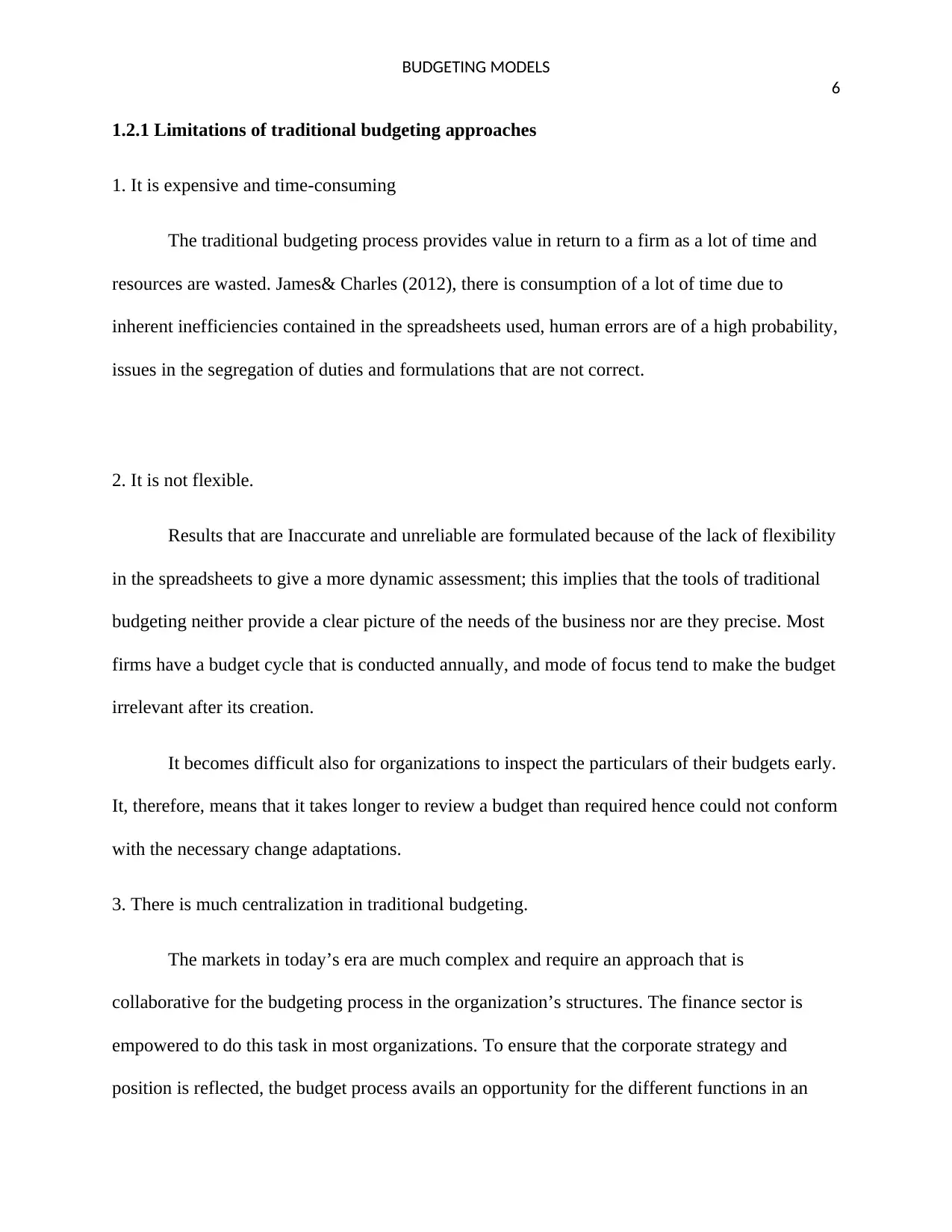
BUDGETING MODELS
6
1.2.1 Limitations of traditional budgeting approaches
1. It is expensive and time-consuming
The traditional budgeting process provides value in return to a firm as a lot of time and
resources are wasted. James& Charles (2012), there is consumption of a lot of time due to
inherent inefficiencies contained in the spreadsheets used, human errors are of a high probability,
issues in the segregation of duties and formulations that are not correct.
2. It is not flexible.
Results that are Inaccurate and unreliable are formulated because of the lack of flexibility
in the spreadsheets to give a more dynamic assessment; this implies that the tools of traditional
budgeting neither provide a clear picture of the needs of the business nor are they precise. Most
firms have a budget cycle that is conducted annually, and mode of focus tend to make the budget
irrelevant after its creation.
It becomes difficult also for organizations to inspect the particulars of their budgets early.
It, therefore, means that it takes longer to review a budget than required hence could not conform
with the necessary change adaptations.
3. There is much centralization in traditional budgeting.
The markets in today’s era are much complex and require an approach that is
collaborative for the budgeting process in the organization’s structures. The finance sector is
empowered to do this task in most organizations. To ensure that the corporate strategy and
position is reflected, the budget process avails an opportunity for the different functions in an
6
1.2.1 Limitations of traditional budgeting approaches
1. It is expensive and time-consuming
The traditional budgeting process provides value in return to a firm as a lot of time and
resources are wasted. James& Charles (2012), there is consumption of a lot of time due to
inherent inefficiencies contained in the spreadsheets used, human errors are of a high probability,
issues in the segregation of duties and formulations that are not correct.
2. It is not flexible.
Results that are Inaccurate and unreliable are formulated because of the lack of flexibility
in the spreadsheets to give a more dynamic assessment; this implies that the tools of traditional
budgeting neither provide a clear picture of the needs of the business nor are they precise. Most
firms have a budget cycle that is conducted annually, and mode of focus tend to make the budget
irrelevant after its creation.
It becomes difficult also for organizations to inspect the particulars of their budgets early.
It, therefore, means that it takes longer to review a budget than required hence could not conform
with the necessary change adaptations.
3. There is much centralization in traditional budgeting.
The markets in today’s era are much complex and require an approach that is
collaborative for the budgeting process in the organization’s structures. The finance sector is
empowered to do this task in most organizations. To ensure that the corporate strategy and
position is reflected, the budget process avails an opportunity for the different functions in an
⊘ This is a preview!⊘
Do you want full access?
Subscribe today to unlock all pages.

Trusted by 1+ million students worldwide

BUDGETING MODELS
7
organization to work as one. Due to the centralization of the budgeting process mainly to the
finance function results to an inaccurate reflection of the firm.
4. It may present an inaccurate goal depiction.
The goals of a firm may be inaccurately represented when some of its managers take
advantage of manipulating the projections. The managers do this with the aim of getting more
attractive actual results that may please the owners/ shareholders of the business. The
manipulation of results is considered as unethical and in the long run it affects the firm.
5. Traditional budgeting fails to encourage desirable behaviours.
This type of system does not encourage people to perform per the company’s interests,
but instead, it motivates managers to engage in unprofessional behaviours and unpleasant
dealings that is not good for the company, it also lowers the dignity of people by creating vertical
control and organization. Furthermore, it instigates barriers in departments through lack of
information sharing.
6. Traditional budgeting model does not take into account a strategic plan, i.e. the model is
deemed not to be well-suited to the drive towards a continuous improvement in the firm
Managers tend to focus more on numbers instead of the real strategic drive of planning.
This method of budgeting focuses typically on how to reduce cost instead of how to create value.
This, therefore, means that there are minimal priorities in strategic plans.
Traditional budgeting has been having a tendency to fixing firms’ response and thinking
to actions in the world that have kept on changing (Andre,2009). This has led to slow flexibility
towards responding to the events mentioned above. Frow, Marginson, & Ogden (2010), in this
7
organization to work as one. Due to the centralization of the budgeting process mainly to the
finance function results to an inaccurate reflection of the firm.
4. It may present an inaccurate goal depiction.
The goals of a firm may be inaccurately represented when some of its managers take
advantage of manipulating the projections. The managers do this with the aim of getting more
attractive actual results that may please the owners/ shareholders of the business. The
manipulation of results is considered as unethical and in the long run it affects the firm.
5. Traditional budgeting fails to encourage desirable behaviours.
This type of system does not encourage people to perform per the company’s interests,
but instead, it motivates managers to engage in unprofessional behaviours and unpleasant
dealings that is not good for the company, it also lowers the dignity of people by creating vertical
control and organization. Furthermore, it instigates barriers in departments through lack of
information sharing.
6. Traditional budgeting model does not take into account a strategic plan, i.e. the model is
deemed not to be well-suited to the drive towards a continuous improvement in the firm
Managers tend to focus more on numbers instead of the real strategic drive of planning.
This method of budgeting focuses typically on how to reduce cost instead of how to create value.
This, therefore, means that there are minimal priorities in strategic plans.
Traditional budgeting has been having a tendency to fixing firms’ response and thinking
to actions in the world that have kept on changing (Andre,2009). This has led to slow flexibility
towards responding to the events mentioned above. Frow, Marginson, & Ogden (2010), in this
Paraphrase This Document
Need a fresh take? Get an instant paraphrase of this document with our AI Paraphraser
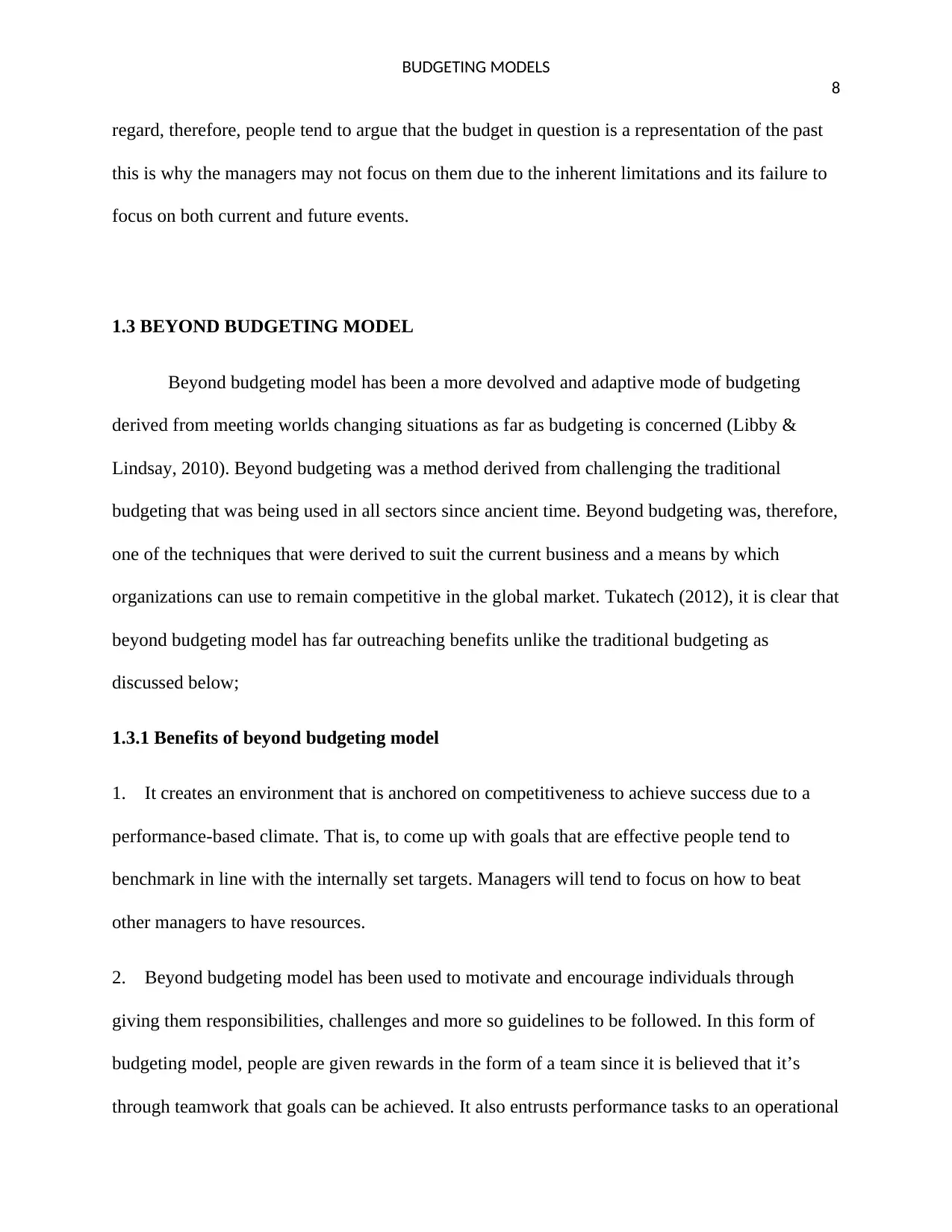
BUDGETING MODELS
8
regard, therefore, people tend to argue that the budget in question is a representation of the past
this is why the managers may not focus on them due to the inherent limitations and its failure to
focus on both current and future events.
1.3 BEYOND BUDGETING MODEL
Beyond budgeting model has been a more devolved and adaptive mode of budgeting
derived from meeting worlds changing situations as far as budgeting is concerned (Libby &
Lindsay, 2010). Beyond budgeting was a method derived from challenging the traditional
budgeting that was being used in all sectors since ancient time. Beyond budgeting was, therefore,
one of the techniques that were derived to suit the current business and a means by which
organizations can use to remain competitive in the global market. Tukatech (2012), it is clear that
beyond budgeting model has far outreaching benefits unlike the traditional budgeting as
discussed below;
1.3.1 Benefits of beyond budgeting model
1. It creates an environment that is anchored on competitiveness to achieve success due to a
performance-based climate. That is, to come up with goals that are effective people tend to
benchmark in line with the internally set targets. Managers will tend to focus on how to beat
other managers to have resources.
2. Beyond budgeting model has been used to motivate and encourage individuals through
giving them responsibilities, challenges and more so guidelines to be followed. In this form of
budgeting model, people are given rewards in the form of a team since it is believed that it’s
through teamwork that goals can be achieved. It also entrusts performance tasks to an operational
8
regard, therefore, people tend to argue that the budget in question is a representation of the past
this is why the managers may not focus on them due to the inherent limitations and its failure to
focus on both current and future events.
1.3 BEYOND BUDGETING MODEL
Beyond budgeting model has been a more devolved and adaptive mode of budgeting
derived from meeting worlds changing situations as far as budgeting is concerned (Libby &
Lindsay, 2010). Beyond budgeting was a method derived from challenging the traditional
budgeting that was being used in all sectors since ancient time. Beyond budgeting was, therefore,
one of the techniques that were derived to suit the current business and a means by which
organizations can use to remain competitive in the global market. Tukatech (2012), it is clear that
beyond budgeting model has far outreaching benefits unlike the traditional budgeting as
discussed below;
1.3.1 Benefits of beyond budgeting model
1. It creates an environment that is anchored on competitiveness to achieve success due to a
performance-based climate. That is, to come up with goals that are effective people tend to
benchmark in line with the internally set targets. Managers will tend to focus on how to beat
other managers to have resources.
2. Beyond budgeting model has been used to motivate and encourage individuals through
giving them responsibilities, challenges and more so guidelines to be followed. In this form of
budgeting model, people are given rewards in the form of a team since it is believed that it’s
through teamwork that goals can be achieved. It also entrusts performance tasks to an operational
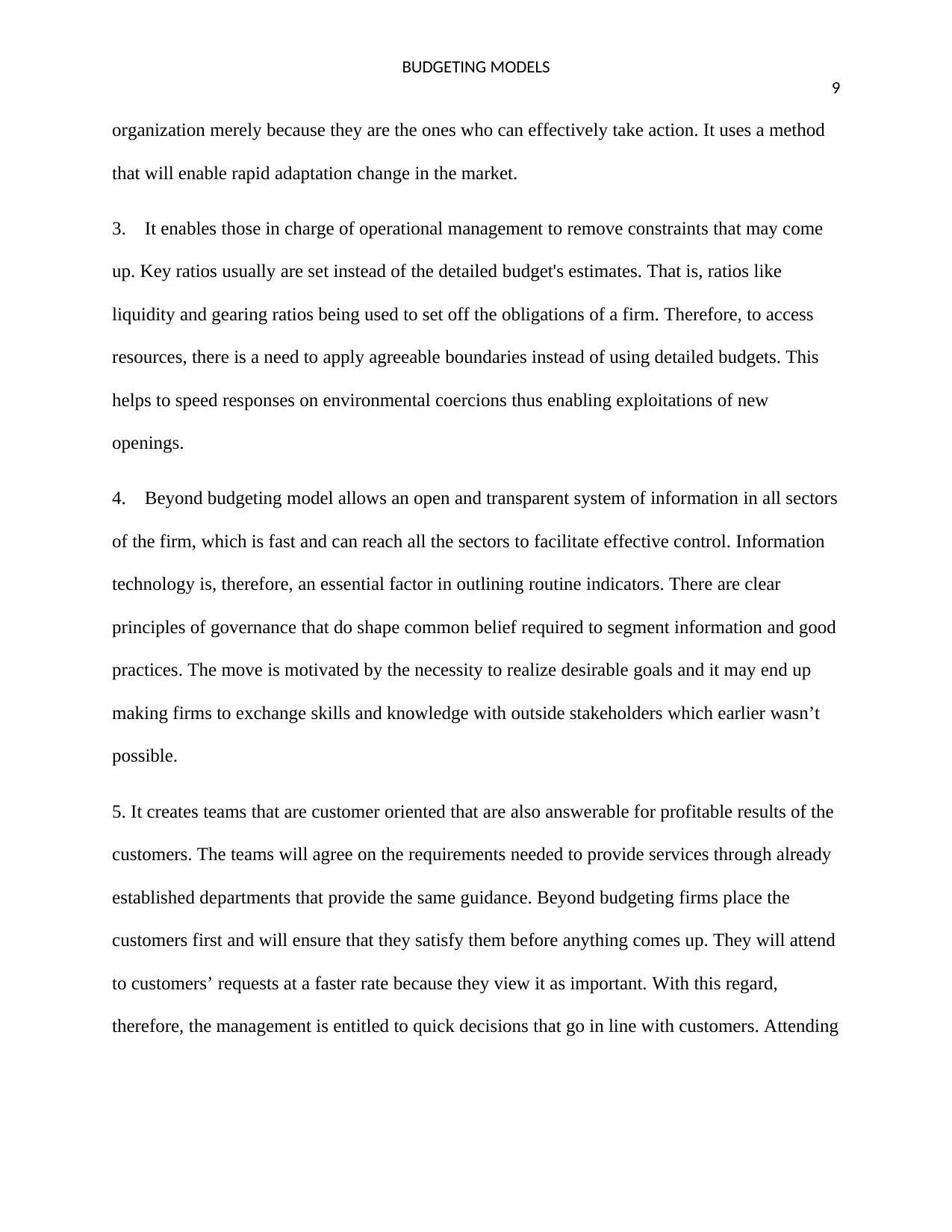
BUDGETING MODELS
9
organization merely because they are the ones who can effectively take action. It uses a method
that will enable rapid adaptation change in the market.
3. It enables those in charge of operational management to remove constraints that may come
up. Key ratios usually are set instead of the detailed budget's estimates. That is, ratios like
liquidity and gearing ratios being used to set off the obligations of a firm. Therefore, to access
resources, there is a need to apply agreeable boundaries instead of using detailed budgets. This
helps to speed responses on environmental coercions thus enabling exploitations of new
openings.
4. Beyond budgeting model allows an open and transparent system of information in all sectors
of the firm, which is fast and can reach all the sectors to facilitate effective control. Information
technology is, therefore, an essential factor in outlining routine indicators. There are clear
principles of governance that do shape common belief required to segment information and good
practices. The move is motivated by the necessity to realize desirable goals and it may end up
making firms to exchange skills and knowledge with outside stakeholders which earlier wasn’t
possible.
5. It creates teams that are customer oriented that are also answerable for profitable results of the
customers. The teams will agree on the requirements needed to provide services through already
established departments that provide the same guidance. Beyond budgeting firms place the
customers first and will ensure that they satisfy them before anything comes up. They will attend
to customers’ requests at a faster rate because they view it as important. With this regard,
therefore, the management is entitled to quick decisions that go in line with customers. Attending
9
organization merely because they are the ones who can effectively take action. It uses a method
that will enable rapid adaptation change in the market.
3. It enables those in charge of operational management to remove constraints that may come
up. Key ratios usually are set instead of the detailed budget's estimates. That is, ratios like
liquidity and gearing ratios being used to set off the obligations of a firm. Therefore, to access
resources, there is a need to apply agreeable boundaries instead of using detailed budgets. This
helps to speed responses on environmental coercions thus enabling exploitations of new
openings.
4. Beyond budgeting model allows an open and transparent system of information in all sectors
of the firm, which is fast and can reach all the sectors to facilitate effective control. Information
technology is, therefore, an essential factor in outlining routine indicators. There are clear
principles of governance that do shape common belief required to segment information and good
practices. The move is motivated by the necessity to realize desirable goals and it may end up
making firms to exchange skills and knowledge with outside stakeholders which earlier wasn’t
possible.
5. It creates teams that are customer oriented that are also answerable for profitable results of the
customers. The teams will agree on the requirements needed to provide services through already
established departments that provide the same guidance. Beyond budgeting firms place the
customers first and will ensure that they satisfy them before anything comes up. They will attend
to customers’ requests at a faster rate because they view it as important. With this regard,
therefore, the management is entitled to quick decisions that go in line with customers. Attending
⊘ This is a preview!⊘
Do you want full access?
Subscribe today to unlock all pages.

Trusted by 1+ million students worldwide

BUDGETING MODELS
10
to customers must also be profitable; hence to measure the profitability becomes an important
factor after accounting for the costs that were used to service the customers.
6. There is a faster response in beyond budgeting. Beyond budgeting firms tend to act with
speed. They also tend to reduce difficulty in management procedure hence an aspect of easiness.
Managers are given a clear scope with strong philosophies, boundaries, and values to be
followed. In conjunction with that managers are allowed to operate with flexibility to make quick
responses to current responses. The firm’s strategies have been made adaptive open and
continuous to allow fast responses in an organization. Beyond budgeting, therefore, has allowed
the organizations to be in a position of countering any pressures and events that may appear.
Harold & Seymour (2012), beyond budgeting model, is relevant for those companies that
are knowledge-based because of their existence concerning development in the economy. Other
organizations also see this as a trend in the rapidly growing and changing atmosphere
(Ostergren& Stensaker, 2011). It is crystal clear therefore that the benefits of beyond budgeting
model in all sectors of organizations, then there is a need to make change in managerial,
organizational and cultural areas.
An example of companies that have adopted the beyond budgeting model include
companies such as the Toyota company, Svenka Handelsbanken, the American airlines, the
Swedish Bank, World Bank among others. By adopting the beyond budgeting model, these
companies enjoy using an adaptive, ethical and lean model that results minimizing the costs,
establishing more strategies that are innovative and faster response in the organization. The
model enables organizations to gain a competitive advantage over their competitors.
10
to customers must also be profitable; hence to measure the profitability becomes an important
factor after accounting for the costs that were used to service the customers.
6. There is a faster response in beyond budgeting. Beyond budgeting firms tend to act with
speed. They also tend to reduce difficulty in management procedure hence an aspect of easiness.
Managers are given a clear scope with strong philosophies, boundaries, and values to be
followed. In conjunction with that managers are allowed to operate with flexibility to make quick
responses to current responses. The firm’s strategies have been made adaptive open and
continuous to allow fast responses in an organization. Beyond budgeting, therefore, has allowed
the organizations to be in a position of countering any pressures and events that may appear.
Harold & Seymour (2012), beyond budgeting model, is relevant for those companies that
are knowledge-based because of their existence concerning development in the economy. Other
organizations also see this as a trend in the rapidly growing and changing atmosphere
(Ostergren& Stensaker, 2011). It is crystal clear therefore that the benefits of beyond budgeting
model in all sectors of organizations, then there is a need to make change in managerial,
organizational and cultural areas.
An example of companies that have adopted the beyond budgeting model include
companies such as the Toyota company, Svenka Handelsbanken, the American airlines, the
Swedish Bank, World Bank among others. By adopting the beyond budgeting model, these
companies enjoy using an adaptive, ethical and lean model that results minimizing the costs,
establishing more strategies that are innovative and faster response in the organization. The
model enables organizations to gain a competitive advantage over their competitors.
Paraphrase This Document
Need a fresh take? Get an instant paraphrase of this document with our AI Paraphraser
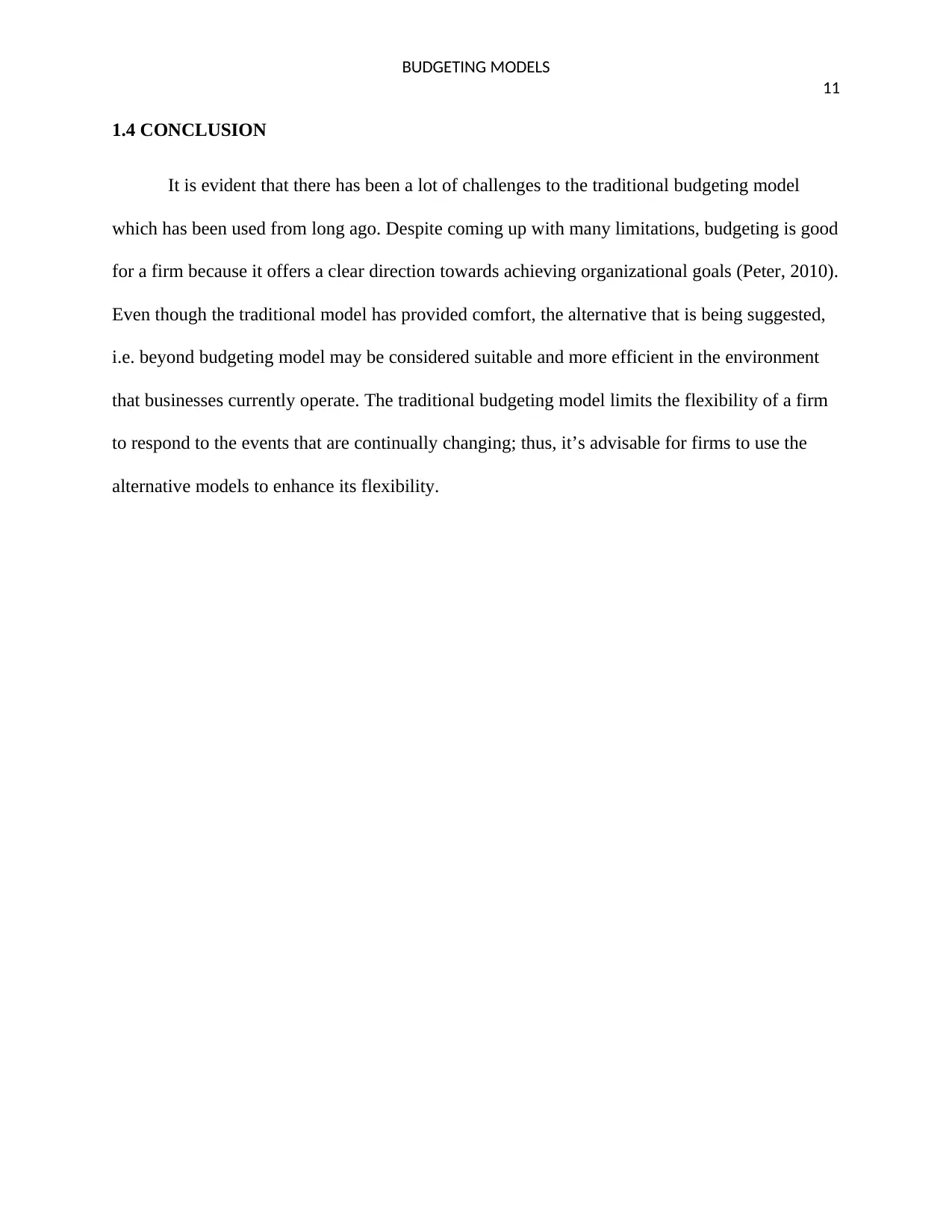
BUDGETING MODELS
11
1.4 CONCLUSION
It is evident that there has been a lot of challenges to the traditional budgeting model
which has been used from long ago. Despite coming up with many limitations, budgeting is good
for a firm because it offers a clear direction towards achieving organizational goals (Peter, 2010).
Even though the traditional model has provided comfort, the alternative that is being suggested,
i.e. beyond budgeting model may be considered suitable and more efficient in the environment
that businesses currently operate. The traditional budgeting model limits the flexibility of a firm
to respond to the events that are continually changing; thus, it’s advisable for firms to use the
alternative models to enhance its flexibility.
11
1.4 CONCLUSION
It is evident that there has been a lot of challenges to the traditional budgeting model
which has been used from long ago. Despite coming up with many limitations, budgeting is good
for a firm because it offers a clear direction towards achieving organizational goals (Peter, 2010).
Even though the traditional model has provided comfort, the alternative that is being suggested,
i.e. beyond budgeting model may be considered suitable and more efficient in the environment
that businesses currently operate. The traditional budgeting model limits the flexibility of a firm
to respond to the events that are continually changing; thus, it’s advisable for firms to use the
alternative models to enhance its flexibility.
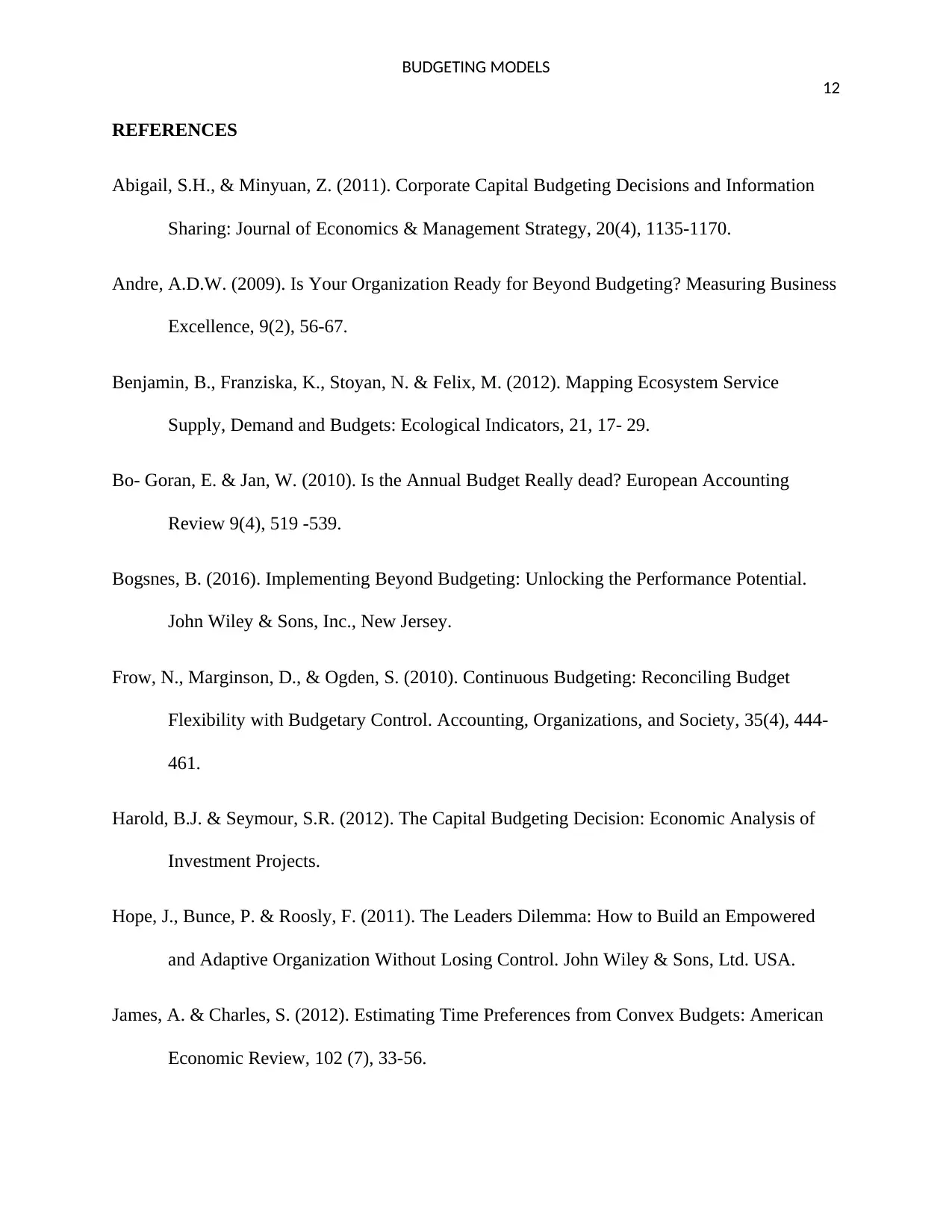
BUDGETING MODELS
12
REFERENCES
Abigail, S.H., & Minyuan, Z. (2011). Corporate Capital Budgeting Decisions and Information
Sharing: Journal of Economics & Management Strategy, 20(4), 1135-1170.
Andre, A.D.W. (2009). Is Your Organization Ready for Beyond Budgeting? Measuring Business
Excellence, 9(2), 56-67.
Benjamin, B., Franziska, K., Stoyan, N. & Felix, M. (2012). Mapping Ecosystem Service
Supply, Demand and Budgets: Ecological Indicators, 21, 17- 29.
Bo- Goran, E. & Jan, W. (2010). Is the Annual Budget Really dead? European Accounting
Review 9(4), 519 -539.
Bogsnes, B. (2016). Implementing Beyond Budgeting: Unlocking the Performance Potential.
John Wiley & Sons, Inc., New Jersey.
Frow, N., Marginson, D., & Ogden, S. (2010). Continuous Budgeting: Reconciling Budget
Flexibility with Budgetary Control. Accounting, Organizations, and Society, 35(4), 444-
461.
Harold, B.J. & Seymour, S.R. (2012). The Capital Budgeting Decision: Economic Analysis of
Investment Projects.
Hope, J., Bunce, P. & Roosly, F. (2011). The Leaders Dilemma: How to Build an Empowered
and Adaptive Organization Without Losing Control. John Wiley & Sons, Ltd. USA.
James, A. & Charles, S. (2012). Estimating Time Preferences from Convex Budgets: American
Economic Review, 102 (7), 33-56.
12
REFERENCES
Abigail, S.H., & Minyuan, Z. (2011). Corporate Capital Budgeting Decisions and Information
Sharing: Journal of Economics & Management Strategy, 20(4), 1135-1170.
Andre, A.D.W. (2009). Is Your Organization Ready for Beyond Budgeting? Measuring Business
Excellence, 9(2), 56-67.
Benjamin, B., Franziska, K., Stoyan, N. & Felix, M. (2012). Mapping Ecosystem Service
Supply, Demand and Budgets: Ecological Indicators, 21, 17- 29.
Bo- Goran, E. & Jan, W. (2010). Is the Annual Budget Really dead? European Accounting
Review 9(4), 519 -539.
Bogsnes, B. (2016). Implementing Beyond Budgeting: Unlocking the Performance Potential.
John Wiley & Sons, Inc., New Jersey.
Frow, N., Marginson, D., & Ogden, S. (2010). Continuous Budgeting: Reconciling Budget
Flexibility with Budgetary Control. Accounting, Organizations, and Society, 35(4), 444-
461.
Harold, B.J. & Seymour, S.R. (2012). The Capital Budgeting Decision: Economic Analysis of
Investment Projects.
Hope, J., Bunce, P. & Roosly, F. (2011). The Leaders Dilemma: How to Build an Empowered
and Adaptive Organization Without Losing Control. John Wiley & Sons, Ltd. USA.
James, A. & Charles, S. (2012). Estimating Time Preferences from Convex Budgets: American
Economic Review, 102 (7), 33-56.
⊘ This is a preview!⊘
Do you want full access?
Subscribe today to unlock all pages.

Trusted by 1+ million students worldwide
1 out of 13
Your All-in-One AI-Powered Toolkit for Academic Success.
+13062052269
info@desklib.com
Available 24*7 on WhatsApp / Email
![[object Object]](/_next/static/media/star-bottom.7253800d.svg)
Unlock your academic potential
Copyright © 2020–2025 A2Z Services. All Rights Reserved. Developed and managed by ZUCOL.

